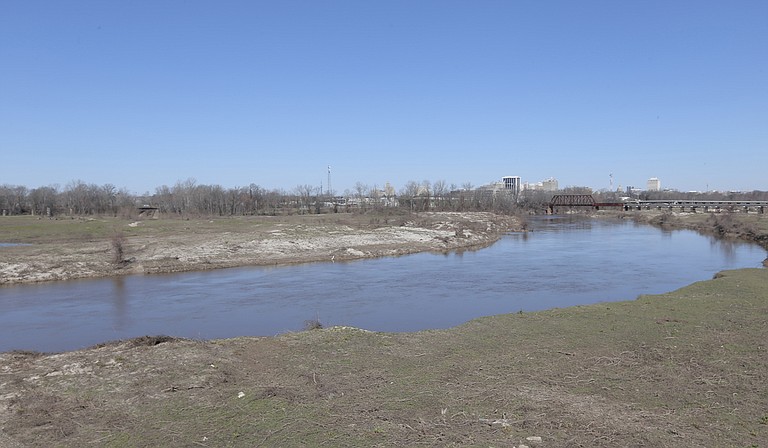Among the alternatives, only the lake development has its own public-relations campaign thanks to John McGowan's nonprofit, Pearl River Vision Foundation, which has consistently promoted dredging and damming the Pearl River to create a 1,500-acre lake. Photo by Imani Khayyam.
Wednesday, October 18, 2017
Flood-control alternatives, including the "One Lake" project for the Pearl River, have been out of the spotlight and the U.S. Army Corps of Engineers' technical review for nearly four years since scoping meetings in fall 2013. When the Environmental Impact Statement and engineering studies are published late in 2017 or early 2018, it will signal the last practical chance for public comment and input until the decision from the assistant secretary of the army for civil works.
The Rankin-Hinds Pearl River Flood and Drainage Control District offered four flood-control alternatives: levees and floodwalls, nonstructural measures, channel improvements and a lake development. Among these alternatives, only the lake development has its own public-relations campaign thanks to John McGowan's nonprofit, Pearl River Vision Foundation, which has consistently promoted dredging and damming the Pearl River to create a 1,500-acre lake. The foundation has also partnered with the drainage district to lobby Congress and the state Legislature to obtain funding for planning and construction. Such a public-private partnership must adhere to public-works spending rules, but that doesn't mean they aren't trying to slant the administrative and legislative procedures their way to achieve a slam-dunk.
This public-private partnership has followed a strategy since 2007 to tip the scales toward the lake-development alternative. In the 2007 Water Resources Development Act, Mississippi's delegation got Congress to authorize $133 million for a Pearl River flood-control project that could be handled outside of the usual Army Corps of Engineers public-works process. Having the project operate under WRDA's Section 211 rules allowed the sponsoring district to handpick its contractors, and self-fund and direct environmental studies and planning documents, with periodic Corps oversight. The 2007 WRDA language for this project also narrowed the study area to Rankin and Hinds counties in the vicinity of Jackson. Restricting the extent of the area controlled costs, but this move could backfire when people on the coast inevitably ask why the studies don't look far enough downstream.
This issue has troubled the marine resource management agencies and oyster industries in both Mississippi and Louisiana.
After those meetings, at the start of the study process, the district took a vote to select the lake project over all the other options as the locally preferred alternative. Then, the district and foundation began "self-funding" their environmental and engineering studies. The Greater Jackson Chamber Partnership, which features a lake as the centerpiece of its Vision 2022 plan, provided money. In 2013, lake sponsors were able to talk Gov. Phil Bryant's Mississippi Development Authority into a $1-million Industrial Incentive Finance Fund Program grant. MDA spends the taxpayers' money, so "self-funding" here means taxpayer-funded.
Battling Pearl River Flooding: The JFP Archive
The JFP's award-winning coverage of efforts to develop and control flooding along the Pearl River.
Some taxpayers live downstream. Given the choice, they wouldn't knowingly help fund a flood-control study by an agency that already voted on a lake and dam—the most environmentally disruptive choice—as its preferred option.
In Congress, the 2016 version of WRDA required the Corps of Engineers to give "expedited review" to the environmental and engineering studies to fast-track the assistant secretary of the army for civil works' decision.
Also, this public-private partnership lobbied the 2017 Mississippi Legislature to enact a tax bill, House Bill 1585, to fund construction of urban-flood-control projects. It gives a flood-control district the authority to tax "property that is directly or indirectly benefitted" by a project. The interpretation of this law is anybody's guess, but its "benefit" language is broad, and spreads a wide net for taxing property owners for bond-debt service within a district.
The drainage district and Pearl River Vision Foundation have friends in Washington, D.C., and Jackson, and have bent the federal and state public works processes toward a lake development that may or may not reduce flooding, but would be a triumph of cronyism. Dredging and damming the Pearl is an economic-development project being sold as flood control.
Unfortunately, the lake option will invite accelerated development in the river's floodplain, compounding future flood-management challenges. The special treatment at the state and federal levels wouldn't happen if this project was only about flooding. Beware the slam-dunk.
For more information, visit the website OneRiverNoLake.com. Andrew Whitehurst is the water program director for the Gulf Restoration Network.



Comments
Use the comment form below to begin a discussion about this content.
Sign in to comment
Or login with:
OpenID